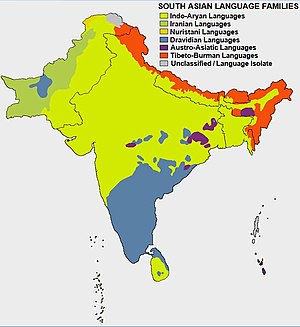Languages of India
| Languages of India | |
|---|---|

|
|
| Official languages |
Hindi English (subsidiary official) 21 other 8th Schedule languages |
| Main foreign languages | |
| Sign languages | |
Languages spoken in India belong to several language families, the major ones being the Indo-Aryan languages spoken by 75% of Indians and the Dravidian languages spoken by 20% of Indians. Other languages belong to the Austroasiatic, Sino-Tibetan, Tai-Kadai, and a few other minor language families and isolates.
The Constitution of India give Hindi language the status of national language and Official language. Article 343 of the Indian constitution states that the official language of the Union shall be Hindi in Devanagari script. The form of numerals to be used for the official purposes of the Union shall be the international form of Indian numerals.
English has the status of a "subsidiary official language". The Eighth Schedule of the Indian Constitution lists 22 languages, which have been referred to as scheduled languages and given recognition, status and official encouragement. In addition, the Government of India has awarded the distinction of classical language to Tamil, Sanskrit, Kannada, Telugu, Malayalam and Odia.
According to Census of India of 2001, India has 122 major languages and 1599 other languages. However, figures from other sources vary, primarily due to differences in definition of the terms "language" and "dialect". The 2001 Census recorded 30 languages which were spoken by more than a million native speakers and 122 which were spoken by more than 10,000 people. Two contact languages have played an important role in the history of India: Persian and English.Persian was the court language during the Mughal period in India. It reigned as an administrative language for several centuries until the era of British colonisation. Up until now, English is an important language in India. It is used in higher education and in some areas of the Indian government. Hindi, the most widely spoken language in India today, serves as the lingua franca across much of North and Central India. However, there have been anti-Hindi agitations in South India, most notably in the state of Tamil Nadu. There is also opposition in non-Hindi belt states towards any perceived imposition of Hindi in these areas.
...
Wikipedia
